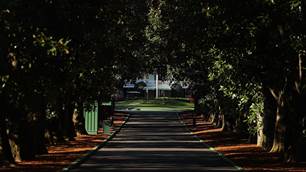The first time I went to Augusta National I was in awe of its colours. They were seductive. The palette of pink, white and fuchsia azaleas and sweeping green fairways punctuated by clean white bunkers is striking to the eye.
It is a benchmark of presentation that no other course in the world can, or should, ever aspire to.
It was once suggested to me by an Augusta local that the budget to prepare the Dr Alister MacKenzie-designed layout for the Masters would equal the combined maintenance budget of 20 courses.
With that in mind on my first walk of the course in 2013, I kept an eye out for any weeds because Augusta National folklore says no one has ever found one – not a dandelion, a leaf of crab grass … nothing. I’ve been to the Masters three times since and I’m still yet to find one. In fact, it is a rarity to find a blade of grass out of place.
“It’s in probably the best condition that I’ve almost ever seen a golf course.” – Marc Leishman
I’ve been playing the same game of ‘eye-spy’ at The Australian Golf Club over the past few days. The weed count remains zero and the colours are impressive, even if their hue has been muted slightly by the low-lying smoke from the NSW bushfires.
Like Augusta, there are expansive beds of bright pink azaleas and the 74 bunkers spread across the property are as white and clean as the best beach you have ever seen. Elsewhere blooming indigo jacarandas provide an Australian touch, despite not being native to this country. And you would struggle to find smoother playing surfaces from tee to green. For the ‘turf nerds’, The Australian has Santa Ana couch fairways (cut at 10mm), Grand Prix couch tees (8mm), common couch rough (44mm) and A1/A4 bentgrass greens (2.8mm), which are projected to run at 11.5 on the Stimpmeter over the four days.

Course superintendent Phil Beal has overseen the presentation of the Jack Nicklaus-design for the past nine years and this is his fourth Australian Open. This week, his greens staff has swelled to 50, including volunteers, to pursue the lofty heights of agronomic perfection. Mission accomplished.
“It’s in probably the best condition that I’ve almost ever seen a golf course,” Marc Leishman said after his Tuesday practice round. Having played the course a number of times during the past 30 years, I couldn’t agree more. It’s flawless.
But if there is one criticism that can be made of The Australian, it is the vast tracts of woodchips scattered beneath the trees right around the course.

There are spots where the woodchips have thinned and exposed sand beneath, which would be far more attractive and a fairer surface within the trees. During the Wednesday pro-am I witnessed an amateur, of some ability, try to hit a shot from the woodchips under the pine trees left of the 17th fairway. He was only a few metres from the edge of the fairway and his ball was sitting on two pieces of woodchip. He knew before he hit his second shot that the result would be a lottery. Aiming right to avoid the lake left, the player struck the shot and the ball went straight left, almost 45 degrees, off the woodchip and into the water. Geoff Ogilvy did similar during the first round of the 2017 Australian Open.
I’ve no doubt there are members of the fiercely private Australian Golf Club that aspire to have their course compared to the famed Augusta National. While the design will never reach the heights of MacKenzie and Bobby Jones’ creation, this week they have a course conditioned to be mentioned in the same sentence.
Related Articles

Australian Open winner will receive invite to The Masters

Scottie Scheffler joins Tiger Woods in rarefied air













